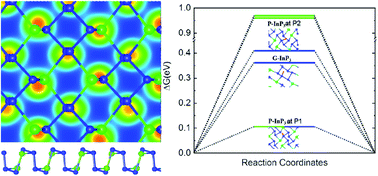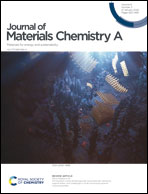A phosphorene-like InP3 monolayer: structure, stability, and catalytic properties toward the hydrogen evolution reaction†
Abstract
Exploring a new phase of two-dimensional (2D) materials with novel electronic and catalytic properties is of particular importance for both fundamental research and practical applications in clean energy. Herein, we report a new phase of the InP3 monolayer with a phosphorene-like structure for the hydrogen evolution reaction on the basis of density functional theory calculations. Our results demonstrate that 2D phosphorene-like InP3 (P-InP3) can be obtained by exfoliating the (0−1 1) surface of the InP3 bulk with a cleavage energy of 1.08–1.37 J m−2, which is more stable energetically than the 2D graphene-like InP3 (G-InP3) monolayer by −0.17 eV per atom. The P-InP3 monolayer is a semiconductor with a direct band gap of 0.53 eV and anisotropic carrier mobility, while its bilayer and trilayer are metallic. In particular, the P-InP3 monolayer, bilayer and trilayer show high catalytic activity toward the hydrogen evolution reaction (HER) comparable to Pt and 1T′-MoS2 on the basis of the calculated Gibbs free energy. Besides, the G-InP3 bilayer and trilayer also exhibit similar catalytic activity. The calculation of the microkinetic process of the HER indicates that both Volmer–Tafel and Volmer–Heyrovsky reactions are possible, but the latter one is more feasible for both P-InP3 and G-InP3. The P-InP3 monolayer is structurally dynamically stable, confirmed with the calculated phonon spectrum and Born–Oppenheimer molecular dynamics simulation in an aqueous environment at 300 K. These findings imply the great potential of the 2D P-InP3 monolayer in electronics, optoelectronics, and catalytic HER.



 Please wait while we load your content...
Please wait while we load your content...